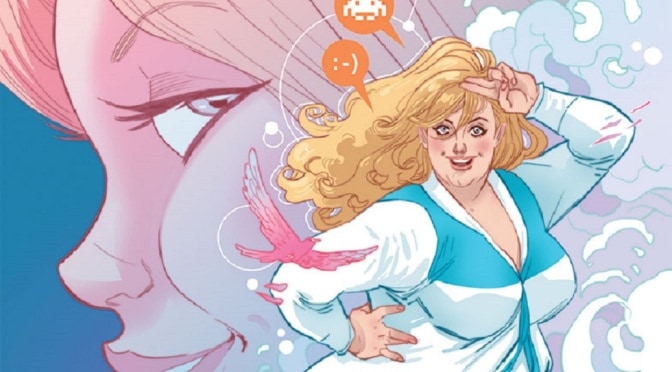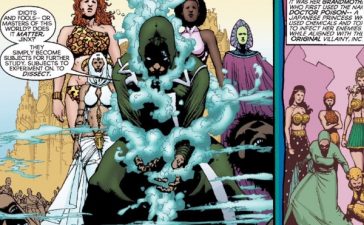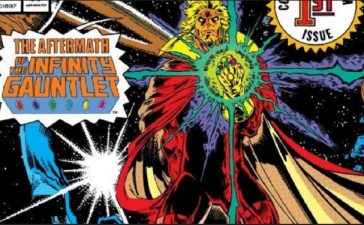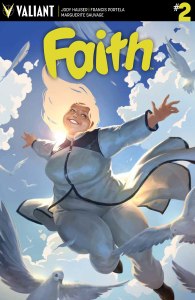 By Jody Houser, Francis Portela, Marguerite Sauvage & Andrew Dalhouse
By Jody Houser, Francis Portela, Marguerite Sauvage & Andrew Dalhouse
It is no secret that I am a fan of Joshua Dysart’s Harbinger in general and the character of Faith Herbert (aka Zephyr) in particular. Created by Jim Shooter and David Lapham in 1992 for the original Harbinger series, she blossomed in the pages of Dysart’s revival title. She quickly became the heart of the loose collection of comrades known as The Renegades. Her plucky can-do spirit was contagious (a trait she shares with other recent breakout female characters such as Ms. Marvel and Squirrel Girl). Following the dissolution of the Renegades, she has bounced around various corners of the Valiant Universe (fighting alien invaders in Mexico and serving a brief stint with Unity). Now she is trying to settle into a new routine, living on her own in Las Angeles while still pursuing her high-flying adventures.
This is the set-up for Valiant’s new Faith limited-series. The first issue spent a fair amount of time (re)introducing the character to readers, ending the chapter on an explosive cliffhanger. As the smoke clears in the opening to #2, Faith is feeling a little dejected. She was able to save several civilians, yet the bad guys got away. She should feel positive about what has happened, but, cannot help dwelling on her failure. Faith grew up on comic books and geek culture; in fact, they are the main connection between her and her deceased parents. Even after all her experiences as Zephyr, she still wishes that life worked the way it did in classic four-color spandex days. Bystanders thank her, police detective ask her for leads. “They know how the story is supposed to go.” So, why does Zephyr feel as though she cannot play her part?
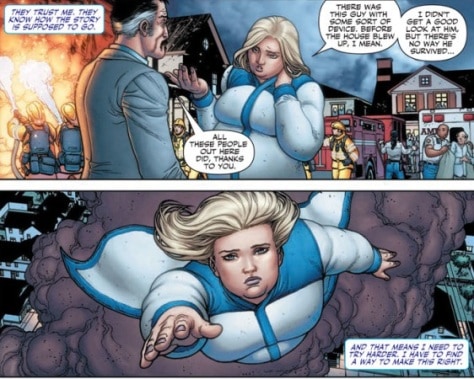 Francis Portela
Francis PortelaWriter Jody Houser does a nice job balancing this tension between fantasy and reality throughout the issue. Faith’s strong moral compass extends beyond superheroing to general life decisions. She turns down offers from former teammate/hacker extraordinaire @x to “transfer” some money into her account. Instead, she dons a wig, glasses and alias to write pop cultural content for Zipline. Problem is instead of smoothly managing the transition between hero and report, ala a certain Man of Steel, Faith finds herself falling asleep in a story meeting and assigned a feature on Something to Torque About, the glitzy (or is it sleazy?) reality show about former Renegade Torque. Did I mention that Faith and Torque had a thing going for a while? Awkward.
The Faith/Torque romance was one of the highlights of the final segment of Harbinger. Dysart naturally nudged together these two characters who in different ways had spent their formative years living in the realm of imagination. They brought out a tender side of each other which was quite touching. The rub was that once they were given the chance to actually live out their fantasy lives, they proved to be incompatible. Torque wanted the glamour of fame, the type of popular validity his bed-ridden, rural youth denied him. Faith on the other hand wanted to be the type of idealistic heroine whose adventures she spent so many hours reading.
In #2 Faith arrives unannounced at Torque’s opulent, hilltop mansion to seek his assistance with her current case. Faith is disappointed to learn that Torque has no interest in taking up superheroing again. He is done with that, viewing his current lush lifestyle as “my reward” for good deeds rendered. Houser is good at mapping out the dynamics of the scene, never letting Torque come off as completely craven. When his current flame knocks Faith’s appearance, he immediately shuts her down. The two may have taken different paths in life, yet, there is the wistful part of him that wishes otherwise.
This contrast between what is and what is not carries over into the art. Most of the issue is illustrated by Francis Portela, who does a fine job working within Valiant’s house style. In addition, though, Houser mixes into the narrative Faith’s daydreams which are illustrated by Marguerite Sauvage. Sauvage lends these sequences a light-hearted vibe which is perfect. Her imagined meeting with Torque hits all the right whimsical notes, including her ex’s confession “I guess I’ll just have to live with this regret forever and ever.” And Faith gets to marry a hunk, so it is all even, right? Not exactly, which is where reality rears its head. Ironically, the final word on the matter comes unknowingly from Faith’s boss at Zipline. Faith is shocked to discover that her piece on Torque’s show was rewritten. When she confronts her boss, she is told to get “a backbone. Write what you really think.” Did some subtext unconsciously slip into Faith’s writing? Does she need to be a little more honest with her emotions?
Overall, this is a strong issue which solidifies Faith’s newfound status as a solo heroine. She demonstrates not only action prowess, but investigative chops as well. I shall admit that I was initially hesitant of anyone but Dysart continuing Faith’s adventures, especially a writer with whom I was unfamiliar. I happy to report that Houser’s Faith is a delightful next step in the character’s development. Faith has a received a fair amount of press for expanding the type of women represented in comics, and this praise is deserved. However, again like her peer and fellow lover of fanfic Kamala Khan, Faith’s series is strong enough to stand on its own merits.
Cheers
Faith #2 will be released by Valiant on Wednesday, February 24th.
Disclosure: Publisher Valiant provided an advance review copy of this comic to Nothing But Comics without any payment between the site and the publisher or agreement on the review’s content.





